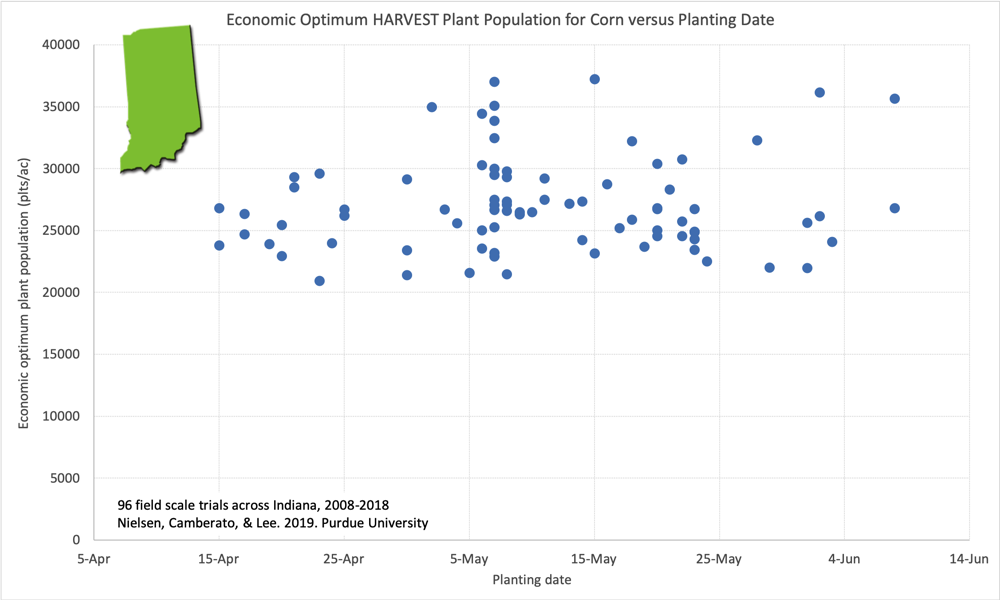May 2019
URL: http://www.kingcorn.org/news/timeless/CornPltPopPltDate.html
Optimum Plant Populations for Delayed Planting of Corn
R.L. (Bob) Nielsen
Agronomy Dept., Purdue Univ.
West Lafayette, IN 47907-2054
Email address: rnielsen at purdue.edu
Twitter: @PurdueCornGuy
The prospect of delayed planting of corn leads corn growers to consider whether changes in seeding rate should be made in response to late planting. The short answer is that optimum plant populations probably remain the same regardless of planting date. Based on 95+ field scale trials conducted around Indiana since 2008 (Nielsen et al., 2019), the average economically optimum HARVEST plant population is surprisingly low for most soils around the state (less than 30,000 plants per acre) and also surprisingly applicable to a wide range of grain yield levels (between about 150 and 250 bu/ac).
Planting dates among those 95+ trials varied by chance from as early as April 15 to as late as June 8. There is no obvious relationship between economic optimum plant population and planting date among those field scale trials (Fig. 1). What that means is that optimum populations for early-planted trials were essentially the same as those for later planted trials.
That conclusion supports what other researchers have also reported over the years in Ohio (Lindsey et al., 2015), Illinois (Nafziger, 1994), and Minnesota (Van Roekel & Coulter, 2011). In both the Ohio and Minnesota research, there was the occasional interaction between planting date and plant population, but overall those studies concluded there was little reason to increase seeding rates with delayed planting.
One caveat to remember is that soils are typically warmer with delayed planting than for "early" planting. Germination, emergence, and stand establishment will occur more rapidly (calendar time basis) with delayed planting and the percentage of planted seeds that become harvestable plants typically is higher (i.e., higher percent stand success). In other words, you may be able to achieve the same desired final population with a slightly lower seeding rate in delayed plantings and save a little on seed costs.

Figure 1. Economic optimum HARVEST plant population for corn versus planting date. Derived from 95+ field scale
trials conducted across Indiana, 2008 to date.
Related reading
Lindsey, A. J., P. R. Thomison, R. Mullen, and A. B. Geyer. 2015. Corn Response to Planting Date as Affected by Plant Population and Hybrid in Continuous Corn Cropping Systems. Crop, Forage & Turfgrass Management 1:2014-0073. doi:10.2134/cftm2014.0073
Nafziger, E. D. 1994. Corn Planting Date and Plant Population. J. Prod. Agric. 7:59-62. doi:10.2134/jpa1994.0059
Nielsen, R.L. (Bob), Jim Camberato, and Jason Lee. 2019. Yield Response of Corn to Plant Population in Indiana. Agronomy Dept, Purdue Univ. http://www.kingcorn.org/news/timeless/CornPopulations.pdf [URL accessed May 2019]
Van Roekel, R. J., and J. A. Coulter. 2011. Agronomic Responses of Corn to Planting Date and Plant Density. Agron. J. 103:1414-1422. doi:10.2134/agronj2011.0071
Acknowledgements
The field scale research summarized in this update was partially supported by funds from the Indiana Corn Marketing Council, the Purdue Mary S. Rice Farm Fund, and the Indiana Certified Crop Adviser Program. Donation of seed corn by Becks Hybrids, DuPont-Pioneer and Stine Seed Company for field trials at Purdue Ag. Research Centers is gratefully acknowledged. Finally, the collaboration of the participating farmers, crop consultants, retail agronomists, county Extension Educators, and Purdue Ag. Research Center personnel is gratefully acknowledged.